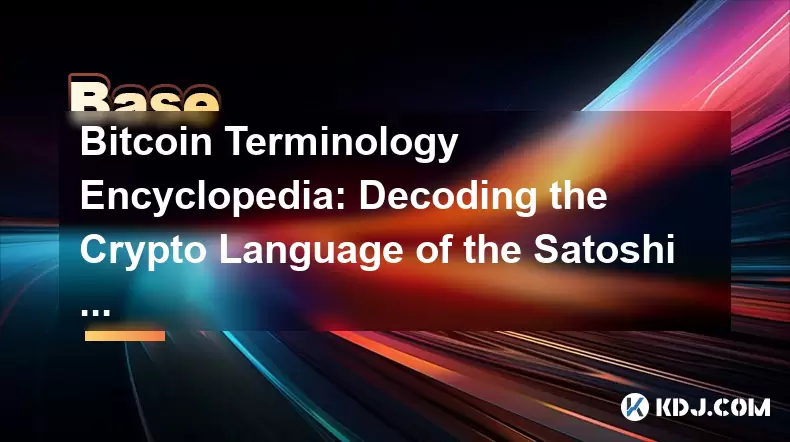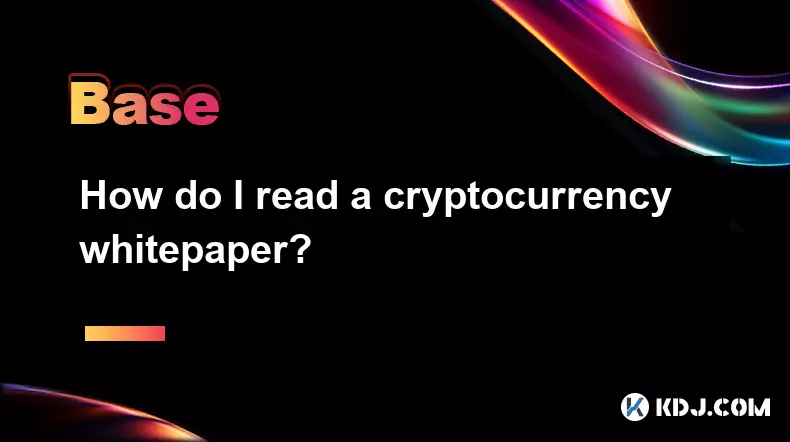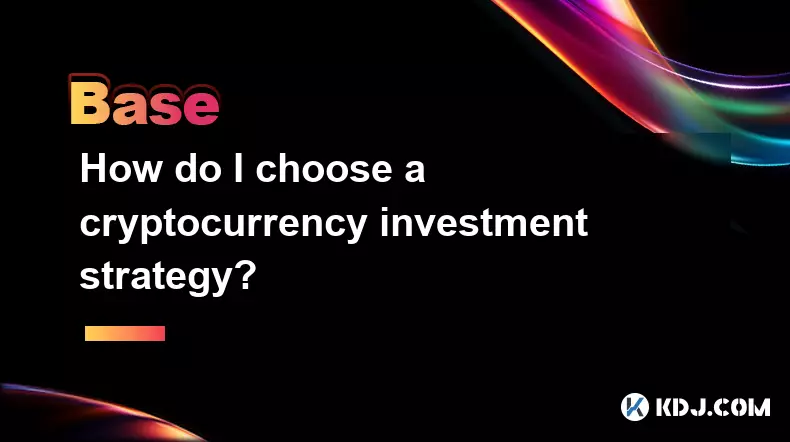-
 bitcoin
bitcoin $114779.865156 USD
2.30% -
 ethereum
ethereum $4226.519789 USD
2.39% -
 tether
tether $1.000545 USD
0.04% -
 xrp
xrp $2.890223 USD
0.92% -
 bnb
bnb $1030.029301 USD
2.95% -
 solana
solana $212.824944 USD
1.69% -
 usd-coin
usd-coin $0.999757 USD
0.01% -
 dogecoin
dogecoin $0.234961 USD
-0.27% -
 tron
tron $0.337174 USD
0.42% -
 cardano
cardano $0.804783 USD
0.09% -
 hyperliquid
hyperliquid $45.748770 USD
-2.85% -
 chainlink
chainlink $21.699170 USD
0.82% -
 ethena-usde
ethena-usde $1.001452 USD
0.08% -
 avalanche
avalanche $30.237800 USD
1.14% -
 stellar
stellar $0.372604 USD
1.52%
Bitcoin Terminology Encyclopedia: Decoding the Crypto Language of the Satoshi Era
Bitcoin, created by Satoshi Nakamoto in 2009, introduced a new era of digital currency with a unique lexicon that shapes the crypto community's language and understanding.
May 11, 2025 at 12:14 pm

Bitcoin, created by the pseudonymous Satoshi Nakamoto, introduced the world to a new era of digital currency. With its inception in 2009, Bitcoin brought along a unique lexicon that has since become integral to the cryptocurrency community. This article aims to decode the crypto language of the Satoshi era, providing a comprehensive understanding of the terminology that shapes the Bitcoin universe.
Bitcoin (BTC)
Bitcoin (BTC) is the first and most well-known cryptocurrency. It operates on a decentralized network, allowing users to send and receive payments without the need for intermediaries like banks. The concept of Bitcoin was first introduced in a whitepaper by Satoshi Nakamoto in 2008, titled 'Bitcoin: A Peer-to-Peer Electronic Cash System.' This groundbreaking paper laid the foundation for what would become a global financial revolution.
Satoshi
The term Satoshi has dual significance in the Bitcoin world. Firstly, it refers to Satoshi Nakamoto, the mysterious creator of Bitcoin. Secondly, a Satoshi is the smallest unit of Bitcoin, equivalent to 0.00000001 BTC. This unit allows for microtransactions, making Bitcoin more accessible for smaller payments. Understanding the Satoshi unit is crucial for anyone looking to engage in Bitcoin transactions, as it breaks down the cryptocurrency into manageable fractions.
Blockchain
Blockchain is the underlying technology that powers Bitcoin and other cryptocurrencies. It is a distributed ledger that records all transactions across a network of computers. Each block in the blockchain contains a list of transactions, and once a block is added to the chain, it cannot be altered, ensuring the integrity and transparency of the system. The blockchain concept is central to Bitcoin's operation, providing a secure and verifiable method of recording transactions.
Mining
Mining is the process by which new Bitcoins are created and transactions are verified on the blockchain. Miners use powerful computers to solve complex mathematical problems, which, when solved, allow them to add a new block to the blockchain. In return for their efforts, miners are rewarded with newly minted Bitcoins and transaction fees. Mining is essential for the functioning of the Bitcoin network, as it maintains the security and decentralization of the system.
Wallet
A Bitcoin wallet is a software program that stores the public and private keys needed to interact with the Bitcoin network. Wallets come in various forms, including desktop, mobile, web, and hardware wallets. Each type offers different levels of security and convenience. To use a Bitcoin wallet, users must generate a Bitcoin address, which is used to send and receive Bitcoins. Understanding how to manage a Bitcoin wallet is vital for anyone looking to hold or transact with the cryptocurrency.
Private Key and Public Key
Private keys and public keys are fundamental components of Bitcoin's cryptographic system. A private key is a secret number that allows a user to spend their Bitcoins. It must be kept secure, as anyone with access to the private key can control the associated Bitcoins. A public key, on the other hand, is derived from the private key and is used to generate a Bitcoin address. The public key can be shared without compromising the security of the private key. Understanding the relationship between private and public keys is essential for maintaining the security of Bitcoin transactions.
Hash
A hash is a cryptographic function that converts an input of any size into a fixed-size output, typically a string of characters. In the context of Bitcoin, hashes are used to secure the blockchain and verify transactions. Each block in the blockchain contains a hash of the previous block, creating a chain of blocks that is nearly impossible to alter. The hash function is a critical component of Bitcoin's security, ensuring that transactions are immutable and verifiable.
Transaction
A Bitcoin transaction is the transfer of value between Bitcoin wallets. It involves sending a certain amount of Bitcoins from one address to another. Each transaction is recorded on the blockchain, making it transparent and verifiable. To initiate a transaction, a user must sign it with their private key, proving ownership of the Bitcoins being sent. Understanding how Bitcoin transactions work is crucial for anyone looking to use the cryptocurrency for payments or investments.
Decentralization
Decentralization is a core principle of Bitcoin, meaning that the network operates without a central authority. Instead, it is maintained by a network of nodes that validate transactions and add them to the blockchain. This decentralized nature ensures that no single entity can control or manipulate the Bitcoin network, making it more resilient to censorship and fraud. Decentralization is what sets Bitcoin apart from traditional financial systems and is a key factor in its appeal.
Peer-to-Peer (P2P)
Peer-to-Peer (P2P) refers to the direct interaction between users on the Bitcoin network. Unlike traditional financial systems, which rely on intermediaries, Bitcoin allows users to transact directly with one another. This P2P nature of Bitcoin enables faster and more cost-effective transactions, as there are no middlemen to slow down the process or charge fees. Understanding the P2P aspect of Bitcoin is essential for appreciating its potential to revolutionize financial transactions.
Frequently Asked Questions
Q: What is the significance of the 21 million Bitcoin cap?A: The 21 million Bitcoin cap is a hard limit set by Satoshi Nakamoto to control the total supply of Bitcoins that will ever exist. This cap is designed to mimic the scarcity of precious metals like gold, potentially increasing Bitcoin's value over time as demand grows. The cap is enforced by the Bitcoin protocol, ensuring that no more than 21 million Bitcoins can be mined.
Q: How does Bitcoin's halving event impact the network?A: Bitcoin's halving event occurs approximately every four years, reducing the reward for mining new blocks by half. This event is programmed into the Bitcoin protocol to control inflation and increase scarcity over time. The halving can impact the network by potentially increasing the value of existing Bitcoins, as the rate of new Bitcoin creation slows down.
Q: What is the role of nodes in the Bitcoin network?A: Nodes are computers that run the Bitcoin software and help maintain the network by validating and relaying transactions. They play a crucial role in ensuring the decentralization and security of the Bitcoin network. Nodes verify that transactions follow the rules of the Bitcoin protocol and help prevent fraudulent activities.
Q: Can Bitcoin be used for everyday transactions?A: Yes, Bitcoin can be used for everyday transactions, although its adoption for this purpose varies by region. Many merchants and businesses accept Bitcoin as a form of payment, and with the use of payment processors, it can be converted to local currency instantly. However, factors such as transaction fees and confirmation times can affect its practicality for small, everyday purchases.
Disclaimer:info@kdj.com
The information provided is not trading advice. kdj.com does not assume any responsibility for any investments made based on the information provided in this article. Cryptocurrencies are highly volatile and it is highly recommended that you invest with caution after thorough research!
If you believe that the content used on this website infringes your copyright, please contact us immediately (info@kdj.com) and we will delete it promptly.
- Meme Coins, October 2025: Best Buys for the Savvy Crypto Investor
- 2025-09-30 12:25:14
- Bitcoin ETF Net Flows: Fueling Developers and Shaping Markets
- 2025-09-30 12:25:14
- Algorand (ALGO) and Proof-of-Stake: Is This the Sleeping Giant?
- 2025-09-30 12:30:01
- QuantNet, Tokenized Money, and Digital Assets: A New Era for Banking
- 2025-09-30 12:45:12
- Rabby Wallet, Statistics, and 2025 Trends: What's the Buzz?
- 2025-09-30 12:30:01
- BullZilla: Meme Coin Primed for Market Takeover?
- 2025-09-30 12:30:01
Related knowledge

How does cryptocurrency achieve decentralization?
Sep 30,2025 at 04:37am
Understanding the Foundation of Decentralization in Cryptocurrency1. Cryptocurrency achieves decentralization primarily through the use of blockchain ...

What are some common methods of cryptocurrency market manipulation?
Sep 27,2025 at 02:55am
Wash Trading and Its Impact on Market Perception1. Wash trading involves an individual or entity simultaneously buying and selling the same cryptocurr...

How do I read a cryptocurrency whitepaper?
Sep 27,2025 at 05:54am
Understanding the Structure of a Cryptocurrency Whitepaper1. Begin by identifying the executive summary, which outlines the project’s core vision and ...

Can I recover lost cryptocurrency?
Sep 25,2025 at 08:18am
Understanding the Nature of Cryptocurrency Loss1. Cryptocurrency operates on decentralized networks, meaning there is no central authority to reverse ...

How do I choose a cryptocurrency investment strategy?
Sep 27,2025 at 03:55pm
Understanding Risk Tolerance in Crypto Investing1. Assessing personal risk tolerance is a foundational step when entering the cryptocurrency market. V...

How can I earn passive income from cryptocurrency?
Sep 23,2025 at 10:18am
Staking Cryptocurrencies for Regular Returns1. Many blockchain networks operate on a proof-of-stake (PoS) consensus mechanism, allowing users to earn ...

How does cryptocurrency achieve decentralization?
Sep 30,2025 at 04:37am
Understanding the Foundation of Decentralization in Cryptocurrency1. Cryptocurrency achieves decentralization primarily through the use of blockchain ...

What are some common methods of cryptocurrency market manipulation?
Sep 27,2025 at 02:55am
Wash Trading and Its Impact on Market Perception1. Wash trading involves an individual or entity simultaneously buying and selling the same cryptocurr...

How do I read a cryptocurrency whitepaper?
Sep 27,2025 at 05:54am
Understanding the Structure of a Cryptocurrency Whitepaper1. Begin by identifying the executive summary, which outlines the project’s core vision and ...

Can I recover lost cryptocurrency?
Sep 25,2025 at 08:18am
Understanding the Nature of Cryptocurrency Loss1. Cryptocurrency operates on decentralized networks, meaning there is no central authority to reverse ...

How do I choose a cryptocurrency investment strategy?
Sep 27,2025 at 03:55pm
Understanding Risk Tolerance in Crypto Investing1. Assessing personal risk tolerance is a foundational step when entering the cryptocurrency market. V...

How can I earn passive income from cryptocurrency?
Sep 23,2025 at 10:18am
Staking Cryptocurrencies for Regular Returns1. Many blockchain networks operate on a proof-of-stake (PoS) consensus mechanism, allowing users to earn ...
See all articles










































































